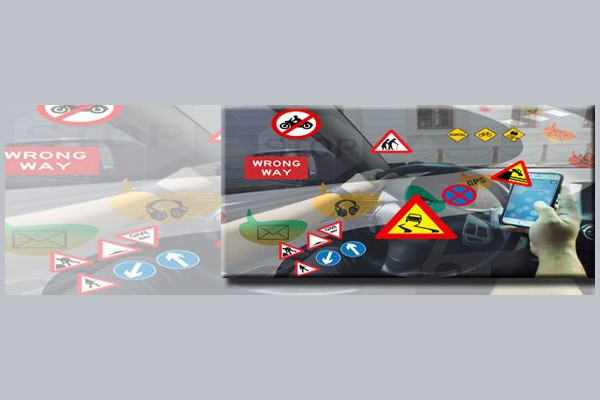“Distracted driving is when you have a beautiful person beside you and you cannot help but stare,” says Uber driver Mark Legate, 58 when asked about Anti-Distracted Driving Act also known as Republic Act 10913. He claims he never uses his cellphone while driving.
Legate’s generation-biased description of distracted driving maybe funny as it is apt for his age. Distracted driving is a creation of the digital revolution. But there is no humor in it being a serious and growing threat to road safety.
There are more mobile phones—about 115 million subscriptions than there are people. This is a good indicator to assume that every driver either possesses or operates a mobile phone while driving. One driver to one smartphone means approximately 9 million possible distracted driving incidents—the estimated number of cars on the road. This number includes about a million motor cycles.
Even with hands-free, in-vehicle communication systems, road crashes resulting from driving distractions can escalate quickly.
Not all drivers are like Legate though.
“Opo, nag te-text po ako kahit nasa biyahe kung importante,” admits Rody P., a provincial bus driver. “Madalas po kung nasa traffic, minsan kahit nasa highway kung talaga pong kailangan.” (I text even while driving if it is important. But mostly when stuck in traffic or when it is really necessary.)
“Kayang kaya naman pong mag text habang nag mo-motor,” King T., delivery rider for a local fastfood company said. “Sanayan lang.” (I can easily text even when riding. You just need practice.) When asked if he realizes it is hazardous, he replied “hindi naman po, basta kaya lang.” (I don’t think so, you just need to get used to it.)
The Anti-Distracted Driving Act is focused on disturbances caused by the use of mobile devices while driving or riding. The number of fatalities and injuries caused by this problem is likely to escalate globally in the coming years. The problem was present as early as the first cellphone but it was only in the last decade when it was was clearly identified and connected to road fatalities.
The law defines “distracted driving,” as “using a mobile communications device to write, send, or read a text-based communication or to make or receive calls,” and “using an electronic entertainment or computing device to play games, watch movies, surf the Internet, compose messages, read e-books, perform calculations, and other similar acts.”
Although still undefined, “similar acts” in the law must be clearly stated in the IRR. Malaya Business Insight Motoring Research Team listed common sources of distraction and similar problems identified by observation for possible inclusion in the IRR, while it has not yet been published.
A World Health Organization (WHO) report penned a report with the U.S. National Highway Traffic Safety Authority called “Mobile Phone Use: A Growing Problem of Driver Distraction,” which connected road crashes and fatalities to mobile phone use. Though the study was done in 2011, the insights are as fresh and relevant five years after.
The study points to the “cognitive distraction” as having the biggest impact on driving behavior that could lead to road mishaps. This distraction can cause drivers to take their eyes off the road, hands off the steering wheel or their minds away from what they need to do which is to drive and react to all the action happening around them.
Other distractions with varying impacts on the driver’s attention to the road include visual, auditory and physical.
Distractions impair driving performance in one or all of the following ways:
1) Creates longer reaction time. A suitable calculation is for every second of distracted driving equals 2 seconds of delay in reaction to avoid a collision, for instance
2) Distraction can impair keeping “in lane”
3) It adds to the braking distance. A 2-second delay in braking for example takes away up to twice the braking distance. If a car will stop in 10 feet, a 2 second delay makes it stop in 20 feet.
4) It can impair the ability to maintain correct speed. Texting while driving slows down the vehicle being usually out of pace.
5) Cuts the field of view in the front. The reduced perspective can affect maneuvering and vehicle control. Lack of control can lead to a road crash.
6) Decreases following distance resulting in tailgating or even worst rear end collisions.
7) Additional mental stress from a phone call for instance can reduce driver awareness, cut down keeping up with the traffic.
The 2015 WHO Global Status Report on Road Safety also points to evidence that mobile phone use while driving increases the risk of being involved in a crash (fatal or not) approximately four times more than a driver not using a phone. It also cites how texting reduces driving reaction times. Inexperienced drivers at a great risk from driving distractions, the WHO Global report states.
“This risk appears to be similar for both hand-held and hands-free phones, because it is the cognitive distraction that is an issue, not only the physical distraction associated with holding the phone. Text messaging appears to have an even more severe impact on driving behavior and crash risk,” the WHO-NHTSA study points out.
The law also holds liable, operators of public utility and commercial vehicles for the action of their employees.
This is to ensure that hiring and training of drivers will include how to avoid situations of distracted driving and increasing accountability of both operator and drivers.
However there are exemptions to the law applying to driver of emergency vehicles or motorists reporting emergency situations.
Last September 21, the 60-days allotted for the Land Transportation Office (LTO) write the law’s implementing rules and regulations (IRR) has lapsed. The IRR lists how the law will be applied to the drivers but it is already clear that violators face a fine of P5,000 for the first offense, P10,000 for the second offense, P15,000 and a three-month suspension of driver’s license for the third offense, and a fine of P20,000 and revocation of driver’s license for succeeding offenses.
This story first appeared on Malaya Business Insight. It is produced under the Bloomberg Initiative-Global Road Safety Media Fellowship implemented by the World Health Organization, Department of Transportation and VERA Files.





